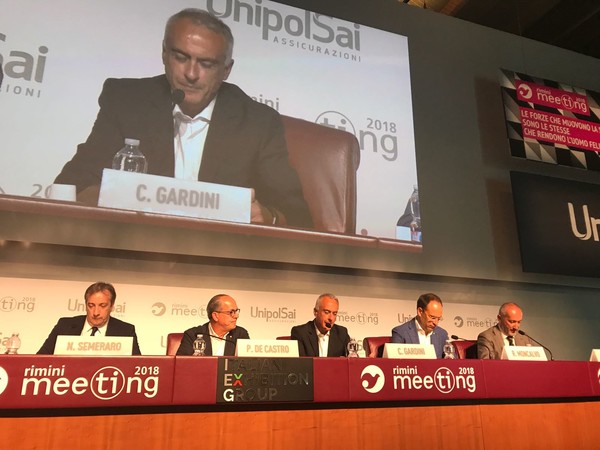
Meeting: space for agricultural machinery and agro-industry supply chain
The Rimini event dedicated attention to Italian Excellence and job opportunities in the agricultural sector and the associated manufacturing industries. A conference held on 21st August brought together leading players and representatives from professional organizations and production consortiums as well as European Union institutions. Also present at the meeting was FederUnacoma with a stand and an area for virtual reality tractor driving
Occupations are created in the Made in Italy winning sectors such as the agro-industry. This message was delivered by Alessandro Malavolti, the president of FederUnacoma, the Agricultural Machinery Manufacturers Federation, who spoke on the issue Enterprise and Occupations in the Agricultural and Forestry Supply Chains at a meeting in Rimini held in 21st August within the Friendship Meeting. He addressed an audience made up mainly by young people to make the point that there are no miraculous formule in the work economy but what is worthy is only the ability interpret the market and evaluate skills and human resources as well as an attitude open to the world of knowledge compared to one’s experience to possibilities in other countries. Other speakers at the conference used these same terms: the director general of the Grana Padano, Stefano Berni; the RILEGNO consortium president Nicola Semeraro; Coldiretti President Roberto Moncalvo; MEP Paolo De Castro, vice-president of the European Parliament Agriculture and Rural Development Committee. In conditions as difficult as these at present was a line taken by many of the speakers introduced by Camillo Gardini, the president of DcO Agroalimentare — who said the agriculture and forestry sector offers job opportunities, also facing the interest of public opinion and consumers are demonstrations of the culture of food and the agro-industry supply chain. Stefano Berni noted that his Grana Padano consortium was formed to enhance production in a territory covering the Veneto, Lombardy, Piedmont and Emilia Romagna and with 4,300 dairy farmers, 127 production sites and 198 packing and marketing companies for a total of 40,000 workers. Nicola Semeraro from the RILEGNO works on gathering and recycling wood raw materials around national territory to supply an industry which would otherwise be forced to import massive raw materials from abroad. On the strength of 400 platforms and 4,500 agreements with Italian municipalities the consortium has furthered excellence in organization and professional competence. Roberto Moncalvo spoke of the origin of the food supply chain and agro-industry with agricultural and forestry activities, of course, activities are now becoming increasingly dynamic and multiform with agriculture capable not only to produce food products but process and market them with the prospect of multifunctions calling also for activities in improving the environment and control of the land. Among the Coldiretti work to heighten the value of the primary sector activities and imagine that farmers themself have cited the Campagna Amica (Friendship Campaign), the battle for Made in Italy and supply contracts which link farmers and the big food industries. Paolo De Castro affirmed that economic and professional projects must be associated in a framework not only nationally but European and that it must be remembered that the beginning of big EU projects are of value for cooperation, progress, innovation, quality and the sustainability of the productive supply chain which must remain a reality. De Castro also underscored the point that these values remain one of the cardinal factors in Malavolti’s statement in which he trained attention on the human factor.
Malavolti stressed the way a company is sent down from father to son with the concept that all energy and resources present must be invested together to achieve results for the collective wellbeing. The agricultural machinery industry thus carried away the contribution of the Rimini Meeting where FederUnacoma installed a stand designed precisely to inform young people of the application of mechanics for agriculture. Among the reasons to note was that the stand set up four locations for virtual reality play based on driving tractors and other agricultural machinery.








